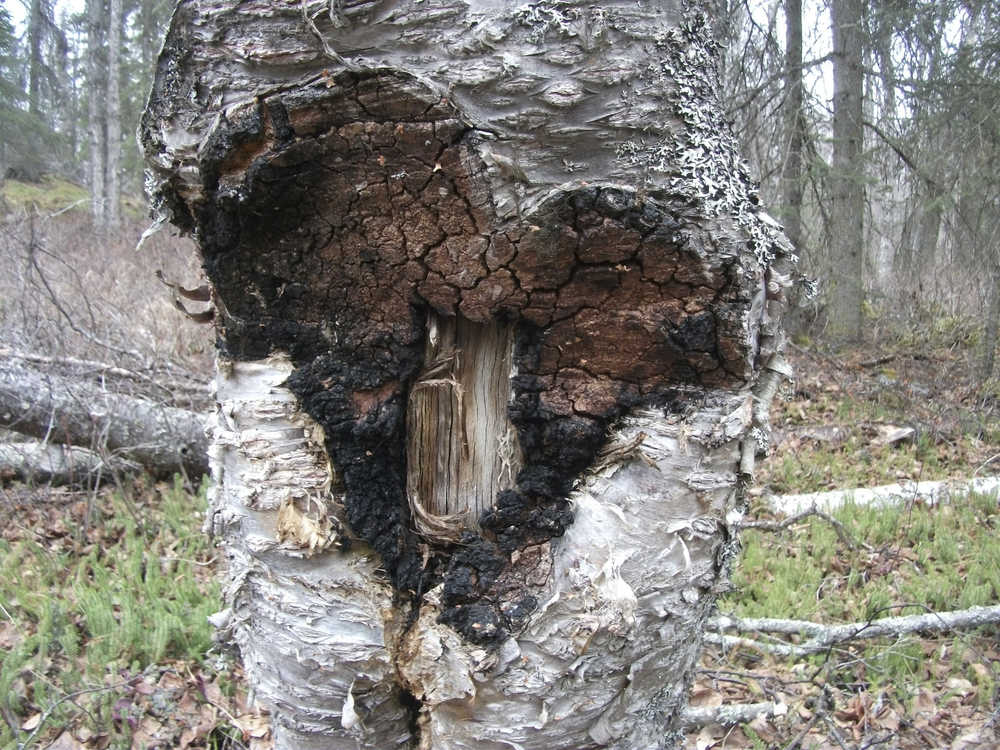“Seeking the name of person who cuts chaga from private property and trails established by locals. Blatant disregard for posted signs and trail cameras. Seen…mutilating Birch trees to retrieve his fortune… He is unable to make his own trail on state land so he visits remote cabins and home sites cutting chaga from their land. … Anyone know of this man, please respond.”
So wrote a Trapper Creek resident this March on Craigslist, but the same is likely happening on the Kenai Peninsula. Corresponding to a rapid growth in interest locally, I have recently been asked more about chaga mushroom (Inonotus obliquus) than any other topic.
Most easily-accessible chaga conchs on Swan Lake and Swanson River Roads, as well as along some of our more popular trails, have already been harvested to the point that people have been hauling out ladders to get at some of the higher conchs. I have also heard a report of commercial operations in southcentral Alaska, with chaga gathered for export to the Asian market. At the moment, there is an ad for chaga at $12/lb. on Kenai Craigslist, the cheapest price I have seen. The going rate is $20-$40/lb. in the Lower 48.
In case you are among the dwindling population of people who haven’t heard about chaga, you may wonder why everyone seems to be chaga crazy. It is the medicinal value of this fungus, an old-time traditional remedy in Russia and other parts of the Old World, that has been driving demand. Unlike many natural medicinals, chaga has become one of the better studied organisms scrutinized by Western Science for its health benefits.
Extracts of chaga have shown demonstrable immune-boosting, anti-oxidant, and anti-cancer properties. I am not going to cover its medicinal uses here, but I encourage the reader to search PubMed for health-related journal articles on Inonotus obliquus.
Due to its growing demand, this slow-growing fungus has been over-collected to the extent that it is becoming far less common in some parts of its range. In response, researchers have developed ways to grow the fungus on artificial media. Unfortunately, these lab-grown chaga mushrooms lack the beneficial medicinal properties of the same fungus on grown on wild birch. It turns out that the medicinally active compounds of chaga are made from precursors produced by the host birch trees.
Given the recent chaga trend, I decided that I had to join the bandwagon and try some. I chopped out part of a conch from a birch on my own property, then followed some of the simper instructions for preparation that I found on-line. I made a simple chaga tea by simmering chunks for several hours on my wood stove, then strained the liquid to yield a dark, mild, smooth, earthy tea. I like it best with a touch of honey to sweeten it slightly, but this is optional as the tea is not bitter. Like so many others, I and the rest of my family have become chaga fans.
Chaga’s second use is as remarkably effective tinder. A friend of mine demonstrated this on Kenai Beach using only a hatchet, a stone from the beach, a chunk of dried chaga, some lichen and birch bark, and a nicely stacked arrangement of kindling. Striking the rock with the hatchet produced a spark that got the chaga going. By blowing on this while holding it next to lichen and birch bark, he grew the initial ember until nearly the whole chaga chunk glowed and smoked. This served to start the fire with surprisingly little fuss.
In nature, the chaga fungus is a lethal pathogen of birch. Chaga usually penetrates the tree through injuries to the bark. The fungus then gradually ramifies vertically and laterally through the trunk, causing a white heart rot that eventually kills its host. Mature chaga ruptures the bark of the tree in places, exposing a black, crumbly, charcoal-like mass of fungal tissue
I must conclude with rules and ethics. As with other mushrooms, it is permissible to harvest chaga conchs on the Kenai National Wildlife Refuge for personal use, but commercial harvest is NOT permitted. Off of the Refuge, be sure to check rules for harvest on other public lands and obtain permission before cutting chaga from private lands.
Where you do gather chaga, be aware that the conchs take several years to grow back after being harvested, so take no more than you will use. Finally, when chopping chaga, do not damage the host tree’s tissues. Take only the fungus. Even though the infection is terminal, the tree may yet fight for its life for decades. Over that time, conchs may be harvested multiple times if proper care is taken.
Matt Bowser serves as Entomologist at the Kenai National Wildlife Refuge. You can find more information at http://www.fws.gov/refuge/kenai/ <http://www.fws.gov/refuge/kenai/> or http://www.facebook.com/kenainationalwildliferefuge <http://www.facebook.com/kenainationalwildliferefuge> .

